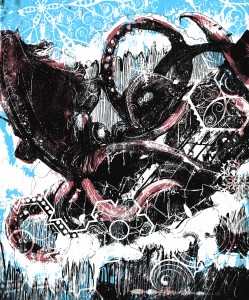An essay by Dr. John P. Armitage, as provided by Joshua Steely
Art by Luke Spooner; Diagrams by Dawn Vogel
Journal of the American Marine Biology Society, Volume 42B, Fall 1956.
Introduction:
Let me begin with a plea for cooperation from my fellow scholars. The constant accusations in these past few months, the debate over who caused the mutant colossal vampire squid problem–and, some go as far as to say, who should be held accountable for its disastrous effect on shipping, the ravaging of coastal cities, and the ensuing environmental disaster from devastated oil rigs–all of this must be put aside. It is not only unseemly in academic discourse, but unhelpful at addressing the issues at hand.
To that end, allow me to offer a few notes of clarification. The species of concern is properly Vampyroteuthis Infernalis ssp. Colossicus, not Architeuthis Vampyricus, as some have erroneously reported. Unlike its non-engineered base form, the Colossicus is aggressive in the extreme. The reasons for this are only of marginal interest, I’m sure. Lastly, yes, they can indeed adapt to fresh water and migrate up sufficiently navigable riverways.
The object of this paper, then, is to summarize recent suggestions for curtailing the cephalopod menace and demonstrate their unfeasibility, then offer my own modest strategy to meet the problem.
~
Recent Proposals Which Must Be Rejected:
Understandably, public opinion is currently heavily in favor of the plan being championed by no less a strategist than Admiral Walker. But let me echo the words of many cool heads in the scientific community and remind readers that the differences between a Teuthida and a U-Boat are many and varied. Tactics developed for use against the latter may have substantially less effectiveness against the former. I trust the rather rash forays undertaken so far bear this criticism out.
Mr. Albright’s suggestion that “we all move farther inland” takes a defeatist attitude I cannot abide. This sort of ostriching, however well-intentioned, only sacrifices our beachhead, which we will badly need for the coming challenge. As an aside, I happen to know on good authority that Mr. Albright is a Communist.
Coming into a more scientific vein, Dr. Whitaker’s Extensive Electric Shock plan, which some critics have so uncharitably dubbed the “pan-oceanic fish-fry proposal,” has much to commend it. But I do side with those suggesting that several currently unsolved problems in electrodynamics remain a barrier to the feasibility of this stratagem.
Also untenable is Senator Forsyth’s exhortation that “those responsible [in his favor, I notice that he does not stoop to naming names, my own included, as some have done] should set to work creating mutant colossal great white shark to combat the cephalopod menace.” Any step down this road would be to court Paddington’s Paradox–an infinite regress of lab-spawned predators successively dominating the ecosystem. Such a strategy is entirely too similar to Social Security, and presages an analogous doom.
It would be tedious to outline the pitfalls of numerous other calls for action, such as the trans-Pacific titanium net, rocket-propelled harpoons, and the increasingly popular “nuke dem squids” strategy being championed by irate crowds outside our nation’s capitol. Calm and finesse will bring us safely through this crisis.

Having gathered our menace into a central location, any number of strategies become feasible for dealing with them: containment (diagram 2, “Prof. Schneider’s Instant Iceberg Encapsulement”), poisoning, the coordinated bombings and depth charges favored by our military luminaries … what have you. The denouement I leave to politicians and the managerial class.
To read the rest of this story, check out the Mad Scientist Journal: Summer 2016 collection.
Dr. John P. Armitage studied at numerous continental universities before completing his doctorate in biochemistry at Latherton University in Arcadia, MA. His dissertation, “Possibilities for Transmutation of Teuthidide Pituitary-Related Processes” won the prestigious Ross-Finkleman prize. For seventeen years he has taught biology and biochemistry at universities across the United States, culminating in holding the Mary Rutherford Chair of Marine Zoology at Latherton since 1952.
Joshua Steely lives in the Midwest with his wonderful wife and son.
Luke Spooner a.k.a. ‘Carrion House’ currently lives and works in the South of England. Having recently graduated from the University of Portsmouth with a first class degree he is now a full time illustrator for just about any project that piques his interest. Despite regular forays into children’s books and fairy tales his true love lies in anything macabre, melancholy or dark in nature and essence. He believes that the job of putting someone else’s words into a visual form, to accompany and support their text, is a massive responsibility as well as being something he truly treasures. You can visit his web site at www.carrionhouse.com.
Dawn Vogel has been published as a short fiction author and an editor of both fiction and non-fiction. Although art is not her strongest suit, she’s happy to contribute occasional art to Mad Scientist Journal. By day, she edits reports for and manages an office of historians and archaeologists. In her alleged spare time, she runs a craft business and tries to find time for writing. She lives in Seattle with her awesome husband (and fellow author), Jeremy Zimmerman, and their herd of cats. For more of Dawn’s work visit http://historythatneverwas.com/.
“Proposals for Addressing the Mutant Cephalopod Problem” is © 2016 Joshua Steely.
Art accompanying story is © 2016 Luke Spooner and Dawn Vogel.
